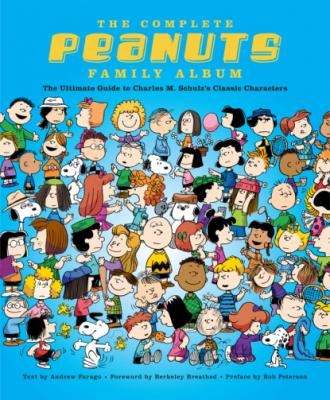The Complete Peanuts Family Album. Andrew Farago
Читать онлайн.| Название | The Complete Peanuts Family Album |
|---|---|
| Автор произведения | Andrew Farago |
| Жанр | Юмористические стихи |
| Серия | |
| Издательство | Юмористические стихи |
| Год выпуска | 0 |
| isbn | 9781681887531 |
one celebrated in this volume. It’s the business I made my
own not much after the above detour in preadolescent
entertainment choices, and Charles Schulz’s characters
played a role, not surprisingly. To be in cartooning is to
really be in “charactooning”—my term (I have no idea
where “car” came from). The comic strips—or movies, or
TV shows, or plays, or novels—that slip from memory
do so for one simple reason that you may test at will: The
personalities that inhabited these ephemeral vehicles were
forgettable.
Character doesn’t just count in comic strips; character
is everything. Making even just a few of them distinct, fun,
separate, and memorable when you only have four tiny
frames each day is a herculean feat. Making dozens and
dozens of them so is something else. Sparky Schulz did that.
Consider just one from Peanuts: my
favorite, Lucy. From the position of a
male writer who does this for a living,
I can tell you that it’s hard to create a
female character without stumbling back
on cliché. Lucy was wildly, wickedly
free from the usual feminine banalities
that girl characters attract like dumb
lumbering bears to honey. She was the
primary female character in Peanuts
and by far the most complex in the
whole gang. When Sparky invented the
very simple allegory of the held (and
inevitably withdrawn) football from the
ever-hopeful Charlie Brown, he brought
comic strips—and their real place in literature—into a
larger world where complex character, as it should, rules.
They gave Bob Dylan a Nobel Prize but neglected Charles
Schulz. That’s almost a punchline.
Peanuts wasn’t a collection of gags (like most comic
strips). It was an assemblage of personalities poured
happily from the mind of one that very skillfully hid his
creative, jubilant schizophrenia behind a genial smile and
a straightforward heart. In 1986, I lay in a hospital bed
with a broken spine after cracking up a small plane . . .
and I opened a package that included a very rare Peanuts
original strip, signed: To Berkeley with friendship & every
best wish—Sparky.
“With friendship.” I’d never met him. Character counts,
indeed. In Sparky’s case, his characters—in all their flaws
and passions and idiosyncrasies—gave a collective voice
to his own character of deep and undisguised humanity.
Explore them here in The Complete Peanuts Family Album
and marvel, like me, that they all came from one creative id.
I wish I’d known him better when I had the chance.
This volume may be the next best thing.
above: Outland strip by Berkeley Breathed | opposite: Design by Cameron + Co
I
went as Charlie Brown for Halloween this past year.
At age fifty-six, I got a few sideways glances. My beard
and glasses with my Charlie Brown bald wig made me look
more like Sigmund Freud Charlie. But I didn’t care. The
whole universe of Peanuts characters that Schulz created is
sacred to me. I remember being in my pajamas as a four-
year-old watching the Christmas special when it first ran
on TV. I read every Peanuts book I could. I identified with
Charlie Brown’s insecurities. I was amazed at the secret,
adventurous world of Snoopy. I was inspired by the spiri-
tuality of Linus and that he could endure the fussbudgetry
of Lucy! I coughed on the sidewalk and then stomped on
the germs. Schulz’s work is in my artistic DNA now. He has
many lessons for us.
Peanuts is such an interesting mix of emotional angst
and surrealism. Somehow the two go together. Who among
us hasn’t felt that the world becomes surreal during times
of angst? I’ve taken that Schulzian idea into my cartooning
and animation career, which includes twenty-three years as
a story artist and screenwriter at Pixar.
In graduate school at Purdue University, I drew a
daily four-panel strip called Loco Motives for the Purdue
Exponent Newspaper. There, I was exploring the angst of
university life but overlaid with a surreal set of characters
including a herbivorous plains-dwelling antelope who just
happened to live with two dudes on campus. Blitzen, as I
called him, could talk, and his antlers (much like Snoopy’s)
could reshape and reflect his emotions. There was no
reason for putting this character in, but I was inspired by
how Snoopy’s surreal world of flying aces and bowling
alleys in his dog house paired nicely with a normal round-
headed boy who found the world mean and indecipherable.
This duality also inspired me on movies like Up, which
is a mix of the grief of Carl Fredriksen and the surrealism
of talking dogs (“Squirrel!”). The two balance and clarify
each other. It seemed like the lower we took Carl in grief,
the more outlandish we could go with Dug and the rest of
the dog pack. Carl’s grief stood out in stark contrast. His
character was clear.
Which is another Schulz lesson: clarity and contrast of
character—we all know what Lucy or Schroeder or Sally
would say or do in any situation. It’s what we in storytelling
grapple with, and I am daily inspired by Schulz’ mastery of
it. In Monsters, Inc., we spent a lot of time at the beginning
just trying to define how Mike Wazowski would contrast
Sulley. As an exercise,
